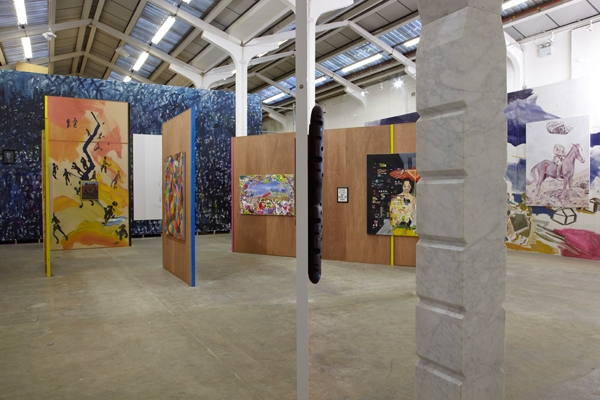I’m standing in front of a painting by Rob Pruitt. A spread of luminescent yellow pigment is sandwiched by fading strips of purple to create something akin to a colour-field painting. The art historical reverence is broken by the addition of a crude, minimally marked smiley face – two scribbled eyes and a childlike mouth – overlaying the yellow expanse.
The road trip has rolled up to Eastside Projects in Birmingham, and I’m at the opening of its pragmatically titled Painting Show – which includes this work by Pruitt, titled Comme ci, comme ca… (2010). Later, Gavin Wade – the artist- curator who in 2008 founded Eastside with Simon and Tom Bloor, Ruth Claxton, James Langdon and Céline Condorelli, drawing on their practices as artists, curators, graphic designers and architects – tells me how they had had trouble getting Pruitt’s 2.9m–wide canvas through the gallery door the previous evening, despite the vaulting architecture of the space, a former cabinetmaker’s workshop. The crate it was delivered in had to be jettisoned outside, and a group of audience members, who had come for a curator’s introduction to the show, were commandeered to help carefully maneuver the work inside.
The anecdote is noteworthy inasmuch as it involves the two key strands that run through Eastside’s strategy: collaboration, be it ad hoc or formally composed, and a physical and conceptual negotiation with the gallery, both as building and institutional entity. This current show, curated by Wade and artist Sophie von Hellermann, sees hardly a surface free of paint for example. Mobile wall panels, designed by architect Adolf Krischanitz for the Secession and on loan from the Vienna institution, have work by von Hellermann applied directly to their MDF surface. Likewise the permanent gallery walls are muralled by Nicolas Party and Tamuna Sirbiladze. Over the top of these interventions hang the work of the 30-odd curated artists. On first entrance it seems like a festival of bad taste. Colours clash, works battle for attention and there seems to be no escape from the gluttonous hang. Then something odd happens, a shift in perception occurs. The gallery handout does not provide immediate orientation – there’s no handy map, just a list of works in sequence, forcing the visitor to first find a painting by an artist he recognises and then identify the other works in relation to this one. Find R.H. Quaytman’s silkscreen on wood, Distracting Distance, Chapter 16 (Woman in the Sun Yellow Scuff ) (2010), for instance, and you’ve identified an example of Paul Thek’s self-labelled ‘bad painting’ hung to its right. Whence, and with perseverance, one can scout out an example of Imran Qureshi’s politically charged work, an intricate, detailed watercolour with gold leaf of a Pakistani slaughterhouse bloodbath, or a heavily handled but affecting abstract painting by Josh Smith. Corralled with these are works that expand the medium beyond the flat surface: Richard Tuttle’s 1998 corrugated cardboard wall sculpture, Boys Let’s Be Bad Boys (5), which sports just a splash of green paint, for example, or Rupert Norfolk’s application of enamel on window blind in Blind II (2008). In plotting one’s path, the viewer is forced out of his traditional role, and the navigation of the exhibition becomes an immersive, concentrated task in which extra attention has to be paid to the physical relationship of the paintings to each other and to the architecture of the temporary walls and gallery space in general. In short, the exhibition becomes less a collection of discrete practices than an installation to be taken as a whole. The act of connecting individual works thematically is usurped by the route-finding exploration of this managed aesthetic that the viewer has been curatorially asked to undertake.
The fact that Wade and von Hellerman’s exhibition is more immersive installation than group show, with the curators’ input looming large, will come as no surprise to the regular Eastside visitor. Previous exhibitions have been titled Curtain Show (2010), Book Show (2010) and Narrative Show (2011), all of which, like this current one, and with a reference to El Lissitzky’s 1920s Abstract Cabinet project, built and played with a relationship between their titular mediums and the gallery itself. So in this latest incarnation, it is as if the architecture of the gallery is offering a critique of the medium of painting, and the paintings of the surrounding built environment.
Wade does not separate his directorship of the gallery from his practice. A founding principle of Eastside, detailed in the gallery’s first ‘User’s Manual’ (which is now in its fourth, evolved edition), is the statement that ‘an artist- run space is not a stop gap’. Wade’s practice, even before the gallery, dealt with structures both social and architectural, and the artist sees Eastside as being a natural continuation of this. The result is a gallery that prides itself on its lack of neutrality and actively seeks to physically express its exhibition history and the personal subjectivity of the director and his multitude of collaborators. Works from old shows hang around. A totemic sculpture by Jennifer Tee has been a permanent fixture in the gallery space since 2010. The handle of the door to the street is by Matthew Harrison. The gallery office is a structure, Pleasure Island, originally designed by Heather and Ivan Morison for the Welsh Pavilion at the Venice Biennale in 2007. Eastside seeks to be a difficult space that must be negotiated, in which the institution is an active collaborator rather than merely a passive enabler.
